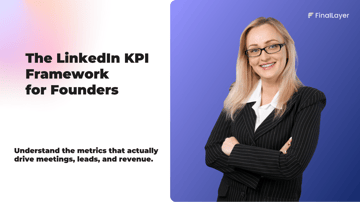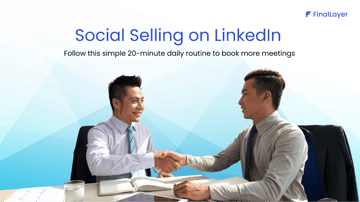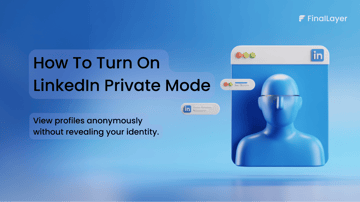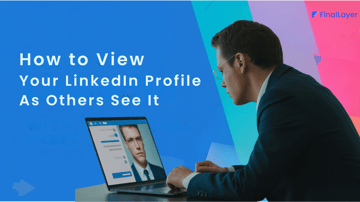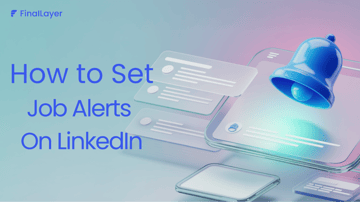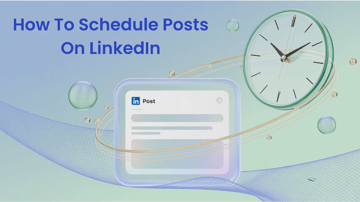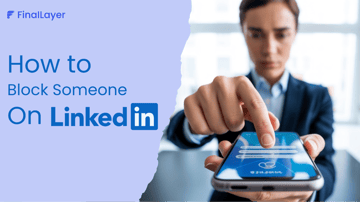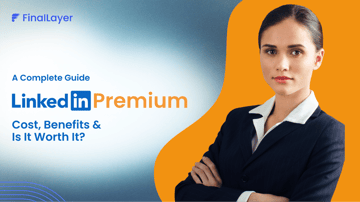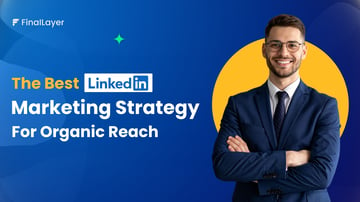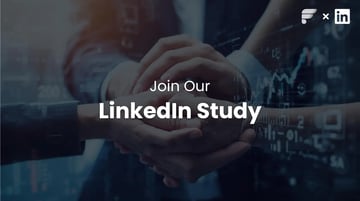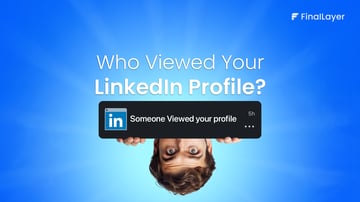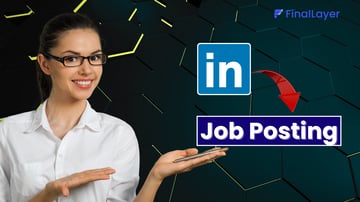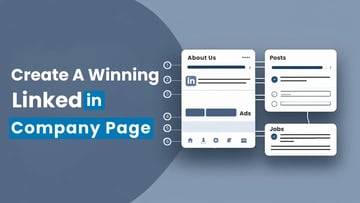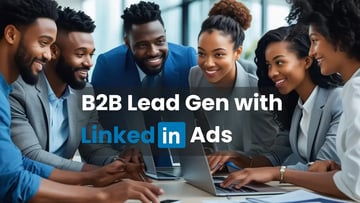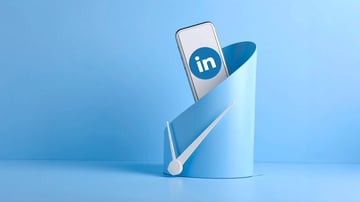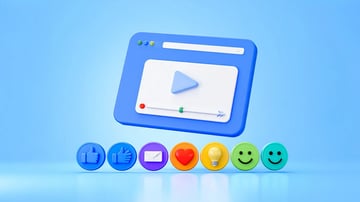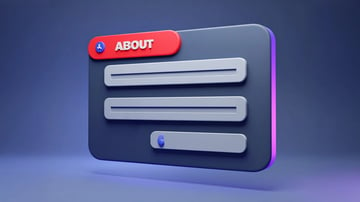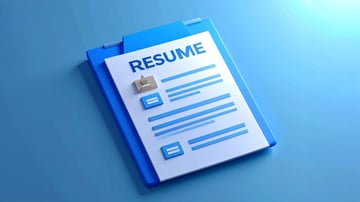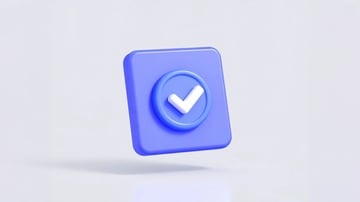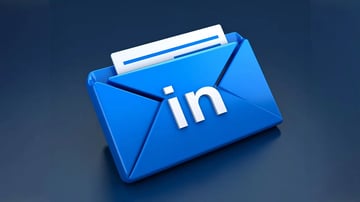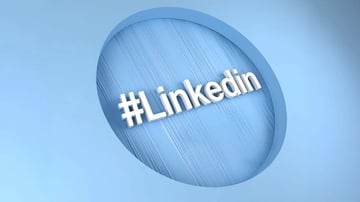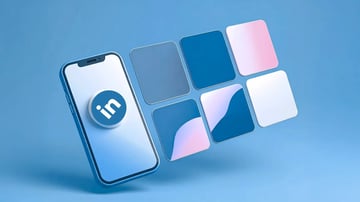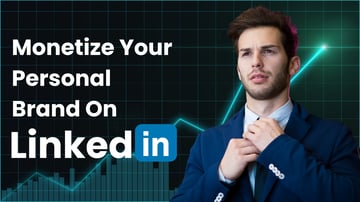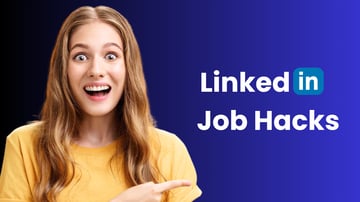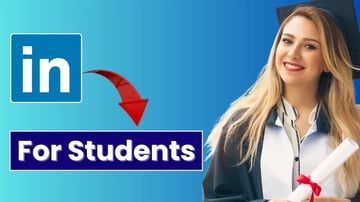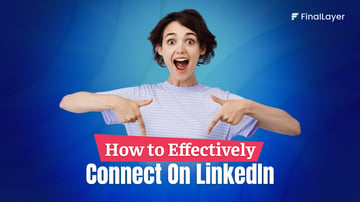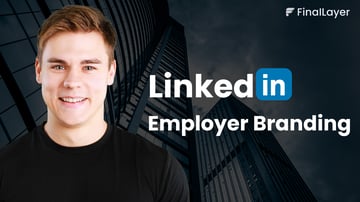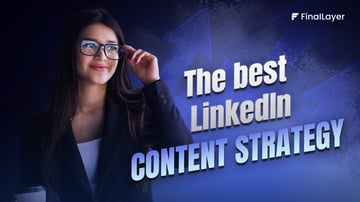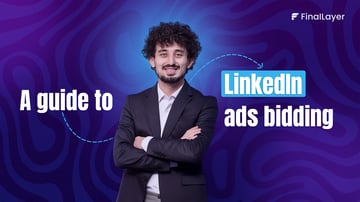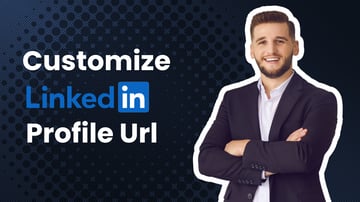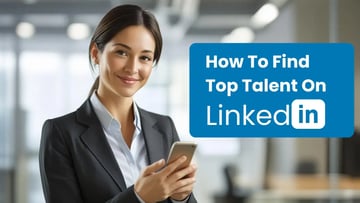LinkedIn B2B marketing refers to using LinkedIn to reach, influence, and convert business buyers, such as founders, executives, managers, procurement teams, and industry professionals.
It combines content marketing, thought leadership, personal branding, employee advocacy, and targeted outreach to build trust with the people who can actually make purchasing decisions.
It’s about educating, influencing, and building relationships that turn into real business opportunities.
Brands use LinkedIn B2B marketing for:
- Lead generation
- Brand awareness
- Recruiting
- Community building
- Demand generation
- Authority positioning
In this blog, you will find everything you need to build a powerful LinkedIn B2B marketing strategy, from content to targeting to LinkedIn ads for B2B marketing to lead generation.
Why LinkedIn Is the Best Platform for B2B Marketing
1. Your Buyers Are Already Here
More than 65 million decision-makers and 10+ million C-level executives actively use LinkedIn. No other platform has this concentration of professionals with purchasing power.
2. Trust Levels Are Higher
People treat LinkedIn as a credible environment. Educational posts, thought leadership, and insights are consumed more seriously here than on any other network.
3. Organic Reach Still Works
Unlike Instagram or Facebook, LinkedIn’s algorithm actively boosts valuable content, especially from individuals.
This means founders, employees, and marketers often outperform brand pages.
4. Intent Is Stronger
People use LinkedIn to learn, research, and evaluate, not to scroll aimlessly.
This makes it a perfect platform for high-ticket and B2B offers.
5. Targeting Is Unmatched
For ads or organic outreach, LinkedIn allows you to target by:
- Job title
- Seniority
- Industry
- Company size
- Skills
- Department
- Location
It’s the ideal platform for Account-Based Marketing (ABM).
The 5 Pillars of Successful LinkedIn B2B Marketing
To win in LinkedIn B2B marketing, you need more than content; you need a system. These are the five core pillars that top-performing B2B brands rely on:
1. Personal Branding for Founders & Leaders
Founders and leaders generate 10x more engagement than company pages. Their voice brings authenticity, storytelling, and credibility that no brand page can replicate.
2. Authority-Driven Content
B2B buyers don’t respond to generic content. They respond to:
- frameworks
- insights
- case studies
- problem-solution breakdowns
- data-driven posts
This positions you more as an expert than a marketer.
3. Consistency That Builds Familiarity
In B2B, buyers don’t convert instantly. But with consistent content, you stay top-of-mind until they’re ready.
Visibility → Trust → Pipeline.
4. Employee Advocacy
Your employees are your biggest distribution engine. Their posts:
- Expand your reach
- humanize your brand
- create multi-perspective influence
A team of 10 employees posting weekly outperforms a company page 20x.
If your company page feels stagnant, isn’t getting the reach you expected, or suffers from inconsistent posting, FinalLayer can help you turn things around. With tools built for both individual creators and company pages, you can publish high-quality, niche-specific content that attracts the right buyers organically.
Whether you want to increase visibility, warm up decision-makers, or drive inbound leads, FinalLayer gives you the structure, ideas, and consistency you need to grow your presence with intention.
5. Community > Pitching
B2B success comes from relationships. Top brands focus on:
- conversations
- comments
- networking
- value-exchange
LinkedIn B2B Marketing Content Strategy (What to Post)
To win in LinkedIn B2B marketing, you need a content strategy that builds trust, demonstrates expertise, and nurtures high-intent buyers over time. B2B audiences don’t convert instantly; they evaluate, observe, compare, and decide slowly. Your content must support that journey.
Here’s the proven B2B content mix that consistently works on LinkedIn:
1. Authority & Thought Leadership Posts
These establish your brand as the one that understands the industry better than anyone.
Post ideas:
- Industry trends and predictions
- Market shifts explained simply
- Common misconceptions in your niche
- "State of the Industry" insights
- Data-backed observations
Why it works:
B2B decision-makers trust logic, clarity, and expertise. Thought leadership positions your brand as a safe, informed choice.
2. Problem–Solution Content
Every B2B sale starts with a problem. Showing you understand it better than competitors builds credibility instantly.
Post structure:
Problem → Impact → Solution → Example → CTA
Examples:
- “Most teams lose X hours/week because…”
- “Here’s why traditional workflows fail…”
- “The fastest way to solve ___ is…”
This content proves your solution is both relevant and necessary.
3. Case Studies & Social Proof
Buyers trust results, show what you’ve done, who you’ve helped, and the outcomes you’ve produced.
Formats:
- Mini case studies
- Before/after transformations
- ROI snapshots
- “Here’s what we shipped this month” progress updates
Keep it data-driven and concise for maximum credibility.
4. Frameworks, Templates & Practical Tips
B2B audiences love content they can immediately apply.
Examples:
- A blueprint for solving a recurring industry problem
- Checklists
- SOPs
- Productivity workflows
- AI prompts for their specific industry
Why it works:
When people save your posts, you win both algorithm points and expert positioning.
5. Founder & Leadership POV Content
People trust people more than logos. Human content drives B2B relationships forward faster than brand content.
Formats that work:
- CEO/founder insights
- Behind-the-scenes decision making
- Vision statements
- Mistakes, learnings, pivots
- Culture & leadership viewpoints
This builds trust at scale.
6. Employee Advocacy Content
Turn your team into micro-influencers. Content from employees performs 5–10x better than brand pages.
Examples:
- Work wins
- Lessons learned
- Team projects
- Hiring posts
- Community highlights
This widens your organic reach dramatically
7. Product Education Content (Soft-Sell)
Avoid pitchy posts and use value-first product education.
Ideas:
- Feature deep-dives
- Use cases by industry
- Comparison posts (“Manual vs AI”)
- “How we built this feature”
- “5 ways our clients use X”
These posts slowly warm your audience into pipeline-ready leads.
8. Carousel Posts & Micro-Visuals
Carousels are the most effective format for B2B on LinkedIn.
Best carousel content types:
- Frameworks
- Problem/solution
- Step-by-step guides
- Market breakdowns
- Tool lists
Why carousels work: High dwell time → stronger distribution → more qualified reach.
9. Comment-Starters (Engagement Boosters)
B2B buyers trust brands with a community. Use opinion-based or conversational content to build that.
Examples:
- “Hot take: In B2B, ___ matters more than ___.”
- “What’s one process in your team that needs fixing?”
- “Agree or disagree: Cold outreach is dying.”
These posts attract the exact people your pipeline needs.
Creating consistent, high-quality B2B content on LinkedIn is one of the hardest parts of marketing, especially when you’re juggling campaigns, messaging, product updates, and stakeholder approvals.
FinalLayer helps B2B teams turn complex ideas into clear, authoritative LinkedIn posts in seconds, aligned with your ICP, your industry, and your brand voice. Whether you're educating buyers, building trust, sharing insights, or positioning your company as an industry leader, FinalLayer gives you a daily stream of content that feels sharp, strategic, and genuinely valuable.
How to Use LinkedIn Ads for B2B Marketing
Unlike Google or Meta, LinkedIn ads target users based on job titles, industries, company size, seniority, skills, and professional interests, making it the most precise B2B advertising platform in the world.
Below is a complete breakdown of how to use LinkedIn Ads effectively for B2B brands
1. Sponsored Content (Best for Awareness + Warm Lead Capture)
Sponsored Content appears directly in the LinkedIn feed and is ideal for promoting educational or top-of-funnel assets.
Best formats for B2B:
- Carousels explaining industry frameworks
- Product explainer videos
- Whitepaper promotions
- Case study highlights
- Thought-leadership posts boosted to more people
When to use it:
Use Sponsored Content when your goals are to
- Grow visibility
- Build authority
- Get engagement from the right audience
2. Lead Gen Forms (Highest B2B Conversion Rates)
LinkedIn Lead Gen Forms auto-fill a user’s data (name, email, company, job title), making the process frictionless.
Best for:
- Webinar signups
- eBook downloads
- Demo requests
- B2B checklists & guides
- Industry reports
Why B2B loves Lead Gen Forms:
- No landing page required
- Higher intent
- Higher conversion rates
- Easy qualification
3. Conversation Ads (For Personalized Outreach at Scale)
Conversation Ads appear in a user's LinkedIn inbox, with a chatbot-style sequence.
Great for:
- Warm lead nurturing
- Product education
- Event invites
- Webinar reminders
- Targeted offers for decision makers
When it works best:
When targeting users who already know your brand or have engaged with your content before.
4. Message Ads (For Direct Offers)
Message Ads are a one-time sponsored message sent directly to the prospect’s inbox.
Use this for:
- Exclusive offers
- Beta access
- High-value invitations
- Networking + consulting offers
(Best used sparingly because inbox ads can feel intrusive.)
5. Dynamic Ads (Hyper-Personalized at Scale)
Dynamic ads pull the user’s name, job title, and photo into the ad creative.
Useful for:
- Driving profile visits
- Promoting newsletters
- Growing followers for your company page
Why they work:
Hyper-personalization increases CTR and makes your brand feel relevant.
6. Retargeting Ads
LinkedIn retargeting allows you to reach users who:
- visited your website
- engaged with your LinkedIn posts
- watched your videos
- opened your Lead Gen Forms
- viewed your company page
Best for mid-funnel campaigns:
✔ Demo invitations
✔ Case study promotions
✔ Feature-based product ads
✔ “Book a call” sequences
Retargeting is often the highest ROI ad format for B2B.
Best Practices for B2B LinkedIn Ads
1. Keep your message simple
Decision makers scroll fast; clarity wins.
2. Speak directly to pain points
Use:
❌ “Increase productivity”
✔ “Reduce onboarding time by 43% with automated workflows”
3. Include social proof
- Case study
- Customer quote
- Numbers
- Logos
4. Use short, clean creatives
Carousels and 15–25 second videos convert best for B2B.
5. Test 3–5 creatives at a time
Never rely on one single ad.
6. Focus on the right CTA
- “Download the guide.”
- “Get the checklist.”
- “See the case study.”
- “Book a demo”
7. Pair LinkedIn Ads with organic content
Organic content = trust
Paid ads = scale
Together = unstoppable B2B lead generation
How to Build a B2B Lead Generation System on LinkedIn
LinkedIn is the only platform where you can reach decision-makers at scale without relying on complicated funnels. Here's how to create a repeatable system:
1. Organic Content + Value-Based Authority
Your organic content builds the top of the funnel (TOFU). It attracts the right audience using:
- Industry insights
- Problem breakdowns
- Use cases
- Customer stories
- Frameworks
- Founder POV posts
- Carousel case studies
This positions your brand as a go-to authority in your space.
2. Soft CTA → Lead Magnet → Capture
Once the right audience engages, direct them towards:
- A guide
- A comparison chart
- A toolkit
- A checklist
- A “playbook”
- A webinar
Soft CTA examples:
“Comment PLAYBOOK and I’ll send you the guide.”
“DM me ‘ROI’ for the full breakdown.”
This moves warm prospects into your CRM without sounding salesy.
3. DM Workflows (Non-Spammy & Personalized)
LinkedIn DMs work only when they're done right.
A clean B2B workflow:
- Identify who engaged with your content
- Check their role, intent, and company fit
- Start with value, not a pitch
DM script example:
“Hey [Name], noticed you’re exploring [topic]. Happy to send you a quick 3-step framework we use with our clients.
This approach gets replies, not eye rolls.
4. Lead Funnels That Actually Work on LinkedIn
Effective B2B funnels look like this:
Content → Engagement → DM → Value Drop → Demo/Call → Proposal
No spam. No automation. No cold pitching. Just momentum → curiosity → conversion.
5. Use Case & Proof-Driven Case Studies
Nothing converts like proof.
Create mini case studies around:
- How a client solved X using your solution
- ROI achieved
- Process breakdown
- Before/after transformation
Format:
Problem → Process → Result → Lesson. This works brilliantly in carousels.
B2B Targeting Strategy: How to Reach the Right Decision Makers
Without the right targeting, even great content fails. Here’s how to ensure your message reaches buyers, not random followers.
1. Targeting Decision Makers (The Real Buyers)
Focus on:
- Founders
- CXOs
- VPs
- Directors
- Team leads
- Senior ICs
Use filters based on:
- Job titles
- Industry
- Company size
- Region
Your content should speak to their pain points, not junior tasks.
2. Targeting by Industry or Vertical
Great for niche B2B markets.
Pick industries where:
- You already have results
- Your product fits naturally
- Buying intent is high
Examples:
- SaaS
- Fintech
- Healthcare
- EdTech
- Agencies
This increases relevance → trust → conversions.
3. Targeting by Job Titles (For Precision)
When building your audience:
- Create a list of 20–30 exact job titles
- Include senior + mid roles
- Identify adjacent roles (Ops, Strategy, RevOps, PMs)
Your content and ads become laser-specific.
Example: Instead of “Marketing,” target:
- Head of Marketing
- Senior Growth Manager
- Demand Gen Lead
- Performance Marketing Manager
4. ABM Strategy (Account-Based Marketing)
This is where LinkedIn shines for B2B.
ABM Workflow:
- Create a list of target companies
- Identify all decision-makers inside each
- Engage with their posts
- Comment with insights
- Publish content addressing their specific problems
- DM them something valuable
- Invite them to a call
You become top-of-mind before the pitch.
Paid + Organic Together = Best B2B Results
The best B2B brands combine:
- Organic content → builds credibility
- Paid ads → accelerate awareness
- DM workflows → create conversions
- ABM targeting → lands high-value clients
This creates a flywheel:
Visibility → Trust → Engagement → Pipeline → Revenue.
Final Thoughts
Treat every post as a small step in shaping how your market perceives you. Focus on clarity, usefulness, and genuine connection. When your content reflects expertise and your outreach reflects intention, your presence becomes a magnet for the right audience. The momentum that follows can transform how your business attracts conversations, opportunities, and partnerships on LinkedIn.

